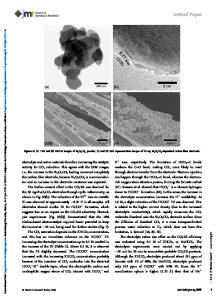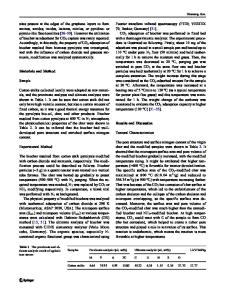Effect of KHCO 3 , K 2 CO 3 and CO 2 on the Electrochemical Reduction of CO 2 into Organics on a Cu Electrode for the So
- PDF / 531,243 Bytes
- 6 Pages / 595.22 x 842 pts (A4) Page_size
- 44 Downloads / 377 Views
Effect of KHCO3, K2CO3 and CO2 on the Electrochemical Reduction of CO2 into Organics on a Cu Electrode for the Solar Energy Conversion and Storage Heng Zhong1, Katsushi Fujii2 and Yoshiaki Nakano3 1 Research Center for Advanced Science and Technology, The University of Tokyo, Tokyo 1538904, Japan. 2 Global Solar plus Initiative, The University of Tokyo, Tokyo 153-8904, Japan. 3 Department of Electrical Engineering and Information Systems, School of Engineering, The University of Tokyo, Tokyo 113-8656, Japan. ABSTRACT Electrochemical reduction of CO2 into useful organics combined with photovoltaics is thought to be one of the promising ways to effectively store and transport the solar energy. In most of the previous researches, CO2 bubbling in different solutions were used as the electrolyte. However, the effects of the electrolyte and the CO2 bubbling are not clear. Therefore, in this research, the effects of different electrolyte, CO2 bubbling, concentration of the electrolyte and temperature on the electrochemical reduction of CO2 on a Cu working electrode were studied. The results showed that the form of the carbon source in the electrolyte, such as HCO3-, CO32and H2CO3, had a strong effect on this reaction, which was controlled by the pH of the electrolyte. Furthermore, high concentration of the HCO3- and elevated temperature can strongly improve the reaction current density. INTRODUCTION It is widely known that solar energy is one of the most promising renewable energies to solve the problem of energy crisis [1,2]. However, the energy storage and transportation systems are needed for a better utilization of the solar energy due to the fluctuation and unequal distribution of the solar energy. It is reported that photoelectrochemical (PEC) water splitting into H2 is a good way to store the solar energy into chemical energy [3]. The conversion efficiency of the PEC process is, however, still very low. This means the current technology is not enough for the real industrial system. Thus separate the PEC process into photovoltaic (PV) and electrochemical (EC) processes would be another promising way to solve such problems because the high energy conversion efficiency could be achieved from the PV part while the high productivity could be obtained from the EC part. In addition, H2 is not a good intermediate for transportation because its energy density per volume is very low and it is hard to be liquefied and easy to explode. Thus, electrochemical reduction of CO2 into useful organics, such as CH4, HCOOH and CH3OH, in water solution using solar energy is regarded to be another promising way [4]. However, in most researches related to PEC or EC reduction of CO2, gaseous CO2 bubbling was used but its effect was obscure [4-6]. Therefore, in this research, the carbonate (CO32-) and bicarbonate (HCO3-) solution were used as the carbon source and their effect were studied and compared with the CO2 bubbling using an electrochemical method on a Cu working electrode. EXPERIMENTAL
It has been widely reported that Cu has the a
Data Loading...











